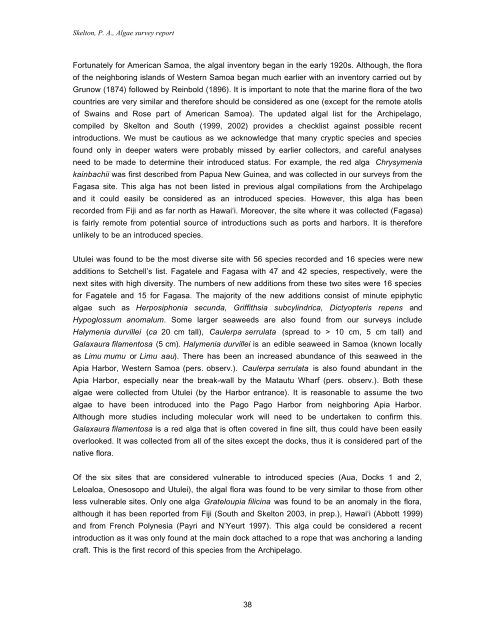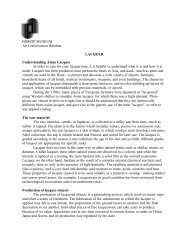INTRODUCED MARINE SPECIES IN PAGO ... - Bishop Museum
INTRODUCED MARINE SPECIES IN PAGO ... - Bishop Museum
INTRODUCED MARINE SPECIES IN PAGO ... - Bishop Museum
You also want an ePaper? Increase the reach of your titles
YUMPU automatically turns print PDFs into web optimized ePapers that Google loves.
Skelton, P. A., Algae survey report<br />
Fortunately for American Samoa, the algal inventory began in the early 1920s. Although, the flora<br />
of the neighboring islands of Western Samoa began much earlier with an inventory carried out by<br />
Grunow (1874) followed by Reinbold (1896). It is important to note that the marine flora of the two<br />
countries are very similar and therefore should be considered as one (except for the remote atolls<br />
of Swains and Rose part of American Samoa). The updated algal list for the Archipelago,<br />
compiled by Skelton and South (1999, 2002) provides a checklist against possible recent<br />
introductions. We must be cautious as we acknowledge that many cryptic species and species<br />
found only in deeper waters were probably missed by earlier collectors, and careful analyses<br />
need to be made to determine their introduced status. For example, the red alga Chrysymenia<br />
kainbachii was first described from Papua New Guinea, and was collected in our surveys from the<br />
Fagasa site. This alga has not been listed in previous algal compilations from the Archipelago<br />
and it could easily be considered as an introduced species. However, this alga has been<br />
recorded from Fiji and as far north as Hawai‘i. Moreover, the site where it was collected (Fagasa)<br />
is fairly remote from potential source of introductions such as ports and harbors. It is therefore<br />
unlikely to be an introduced species.<br />
Utulei was found to be the most diverse site with 56 species recorded and 16 species were new<br />
additions to Setchell’s list. Fagatele and Fagasa with 47 and 42 species, respectively, were the<br />
next sites with high diversity. The numbers of new additions from these two sites were 16 species<br />
for Fagatele and 15 for Fagasa. The majority of the new additions consist of minute epiphytic<br />
algae such as Herposiphonia secunda, Griffithsia subcylindrica, Dictyopteris repens and<br />
Hypoglossum anomalum. Some larger seaweeds are also found from our surveys include<br />
Halymenia durvillei (ca 20 cm tall), Caulerpa serrulata (spread to > 10 cm, 5 cm tall) and<br />
Galaxaura filamentosa (5 cm). Halymenia durvillei is an edible seaweed in Samoa (known locally<br />
as Limu mumu or Limu aau). There has been an increased abundance of this seaweed in the<br />
Apia Harbor, Western Samoa (pers. observ.). Caulerpa serrulata is also found abundant in the<br />
Apia Harbor, especially near the break-wall by the Matautu Wharf (pers. observ.). Both these<br />
algae were collected from Utulei (by the Harbor entrance). It is reasonable to assume the two<br />
algae to have been introduced into the Pago Pago Harbor from neighboring Apia Harbor.<br />
Although more studies including molecular work will need to be undertaken to confirm this.<br />
Galaxaura filamentosa is a red alga that is often covered in fine silt, thus could have been easily<br />
overlooked. It was collected from all of the sites except the docks, thus it is considered part of the<br />
native flora.<br />
Of the six sites that are considered vulnerable to introduced species (Aua, Docks 1 and 2,<br />
Leloaloa, Onesosopo and Utulei), the algal flora was found to be very similar to those from other<br />
less vulnerable sites. Only one alga Grateloupia filicina was found to be an anomaly in the flora,<br />
although it has been reported from Fiji (South and Skelton 2003, in prep.), Hawai‘i (Abbott 1999)<br />
and from French Polynesia (Payri and N’Yeurt 1997). This alga could be considered a recent<br />
introduction as it was only found at the main dock attached to a rope that was anchoring a landing<br />
craft. This is the first record of this species from the Archipelago.<br />
38






